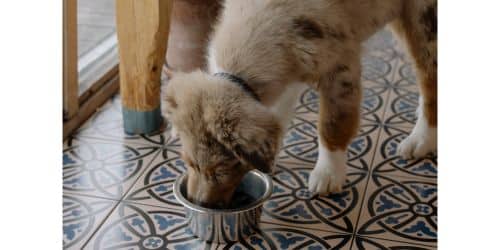Our cherished canine companions’ health and well-being are always top priorities. We endeavor to give the greatest nourishment to our pets as responsible pet parents. But have you ever thought to yourself, “Does dog food expire?” In this comprehensive guide, we will delve into the intriguing realm of dog food expire dates, throwing light on the significance of expiration dates, variables influencing food spoilage, proper storage procedures, and much more. So, let’s go down and discover the truth about your pet’s food expiration.
The Significance of Expiration Dates:
The expire date on dog food packaging is an important indicator of the product’s freshness and safety. Manufacturers decide these dates through extensive testing and analysis to verify that the food fulfills nutritional criteria and is safe for consumption. They indicate when the food is at its best in terms of quality, flavor, and nutrient content.
Differentiating Between “Best By” and “Use By” Dates:
Dog food packaging frequently includes a “Best By” or “Use By” date. While these phrases appear to be equivalent, they have distinct meanings. “Best By” dates reflect the period in which the food retains its best quality, flavor, and nutritional value. “Use By” dates, on the other hand, indicate the date by which the food should be consumed for safety reasons, as it may become unsafe or less palatable after that time.
The Importance of Following Expiration Dates:
Respecting expiration dates is critical to ensuring that your dog receives the best and safest nourishment possible. Consuming expired food can result in a loss of flavor, and nutritional value, and potential health hazards. As a result, it is advisable to follow the manufacturer’s recommended guidelines.
Factors Influencing Dog Food Spoilage:
Several causes can contribute to dog food deterioration, even if it is still within its shelf life. Air, moisture, heat, sunlight, and pests can all hasten deterioration. Furthermore, poor storage procedures, such as leaving food out in the open or exposing it to severe temperatures, might jeopardize its quality and safety.
Signs of Spoiled Dog Food:
It is critical to recognize indicators of spoilt dog food to protect your dog’s health. A rotten or offensive odor, mold growth, odd texture or appearance, pest infestation, or color change are examples of these. If you observe any of these symptoms, it is better to throw out the food and start over.
Understanding expiration dates is critical for ensuring that your dog’s food is fresh and safe. Differentiating between “Best By” and “Use By” dates allows you to identify the food’s ideal quality and safety. Following expiration dates is critical for preserving nutritional content and reducing potential health hazards.
Shelf Life of Dog Food
The shelf life of dog food refers to the amount of time that it will retain its quality and nutritional value if properly stored. This time varies depending on the type of food (dry, moist, or uncooked), the ingredients, processing methods, and preservatives utilized.
- Dry Dog Food: Dry dog food, often known as kibble, generally has a longer shelf life than wet or raw food. When stored in a cold, dry place and properly sealed, it can last anywhere from six months to a year or even longer, depending on the brand and formulation.
- Wet Dog Food: Due to its increased moisture content, wet dog food packaged in cans or pouches has a shorter shelf life. Unopened cans or pouches can typically be consumed safely within two to five years, depending on the manufacturer’s recommendations. However, once opened, it must be refrigerated and consumed within a few days.
- Raw Dog Food: When compared to other types of dog food, raw dog food, including frozen or freeze-dried variants, is barely processed and has a shorter shelf life. To retain its safety and nutritional integrity, it should be stored in the freezer and consumed within the time range provided by the manufacturer.
- Checking Expiration Dates and Batch Codes: To guarantee that you’re giving your dog fresh food, check expiration dates and batch codes before purchasing. These codes might provide useful information about the product’s creation date and assist you in determining its freshness.
Does Dog Food Expire
Yes, dog food does expire. Dog food, like any other perishable product, has a limited shelf life. The expire date on dog food packaging specifies the timeframe during which the food should be consumed to maintain its freshness, flavor, and nutritional value. Consuming outdated dog food can result in a loss of flavor, nutrient degradation, and potential health problems for your pet.
It is crucial to remember that the shelf life of different varieties of dog food, such as dry kibble, wet food, or raw food, may vary. Due to its reduced moisture level, dry dog food has a longer shelf life than wet or raw food. To maintain your dog’s safety and well-being, regardless of the type of dog food, it is critical to verify the expire date and observe suitable storage methods.
Even within its shelf life, exposure to air, moisture, heat, sunlight, and vermin can hasten the spoilage of dog food. Improper storage procedures, such as leaving food out in the open or exposing it to high temperatures, can jeopardize its quality and safety.
Examine the packaging carefully and look for the expire date to see if the dog food has expired. In addition, keep an eye out for any indicators of spoiling, such as a rancid odor, mold growth, strange texture or appearance, pest infestation, or color change.
Dog food has an expire date, and it is critical to adhere to those dates to preserve the quality and safety of the food you feed your dog. You can ensure that your pet receives fresh and nutritious meals that contribute to their overall health and well-being by checking expiration dates, following correct storage techniques, and being attentive to symptoms of deterioration.
Proper Storage Practices
Proper storage methods are critical in maintaining the quality and safety of dog food. Following these rules will allow you to increase the shelf life of your food while maintaining its nutritious content.
Container Sealing and Airtightness:
It is best to preserve dog food in its original packaging or transfer it to airtight containers to protect it from air and moisture. This protects the food from environmental conditions that could hasten spoilage. Airtight containers help to keep food fresh and prevent pests from getting it.
Avoiding High Temperatures:
Exposure to extreme temperatures can compromise the quality and safety of dog food. It is best to store dog food in a cool, dry place away from direct sunlight and sources of heat.
Proper Handling of Opened Packages:
It is critical to handle dog food carefully once it has been opened to keep it fresh. Reseal the packaging tightly to reduce air exposure and moisture entry. Consider using clips or transferring the food to airtight containers if the original package does not have a resealable feature.
FIFO (First-In, First-Out) Method:
The FIFO approach is recommended to ensure that your dog consumes fresh food. Using older food first and placing recent purchases at the back of the storage room is what FIFO stands for. This allows you to rotate through the food inventory and reduces the likelihood of food sitting over its expiration date.
Avoiding Cross-Contamination:
Store dog food away from other perishable products or cleaning supplies to avoid cross-contamination and protect the quality of the food. It’s best to designate a specific area or cabinet for storing pet food to reduce the risk of accidental contamination.
How long does dog food last after the expiration date?
The expiration date on dog food packaging specifies the ideal duration for retaining the food’s freshness, flavor, and nutritional content. To guarantee the best freshness and safety, it is normally recommended to consume the dog food before the expire date.
After the expire date, the quality and nutritional value of the dog food may begin to deteriorate. The pace of deterioration might vary depending on factors such as dog food type, storage conditions, and exact components used.
While some dog food may be acceptable to use after the expiration date, it is typically advised to err on the side of caution and avoid giving your dog expired food. Consuming expired dog food may result in a loss of flavor, nutrient deterioration, and an increased risk of microbial contamination.
If your dog food has passed its expiration date, it is recommended to discard it and replace it with a new batch to ensure your dog gets the best nutrition possible. It’s crucial to note that the shelf life of dog food varies depending on brand, formulation, and type (such as dry kibble, wet food, or raw food). Always read the manufacturer’s guidelines and the expiration date on the box for the most up-to-date information on the shelf life of a specific dog food product.
Can you use expired dog food?
Using expired dog food is generally not recommended. The expiration date on dog food packaging acts as a guideline to assure the product’s freshness, quality, and safety. Consuming expired dog food can endanger the health and well-being of your dog. After the expiration date, the nutritional value and quality of the dog food may begin to deteriorate.
How do you know if dog food is expired?
To determine if dog food is expired, there are several key indicators to consider. Here are some signs to look for:
- Expiration Date
- Odor
- Mold or Discoloration
- Texture and Consistency
- Pest Infestation
It’s crucial to remember that some changes in dog food, such as natural separation or oil stains, are typical and aren’t always indicative of spoiling.
Can dogs get food poisoning from expired food?
Yes, dogs can get food poisoning if they eat expired food. Dogs, like humans, are vulnerable to the detrimental effects of eating damaged or expired food. Expired dog food may contain dangerous bacteria like Salmonella or E. coli, which can cause foodborne diseases in dogs.
How long does dog food last in the fridge?
The shelf life of dog food in the fridge varies according to the type of dog food and its ingredients. Wet or canned dog food can usually be refrigerated for 2 to 3 days after opening. It is critical to read the packaging or follow the manufacturer’s instructions for any special recommendations.
When keeping opened wet dog food in the fridge, remove any residual food from the can to a covered container. This keeps it fresh and keeps it from absorbing odors from other items in the fridge.
Conclusion
Dog food does expire, and pet owners must be aware of expiration dates and proper storage methods to ensure their furry friends enjoy safe and nutritious meals. Understanding the relevance of expiration dates, distinguishing between “Best By” and “Use By” dates, and recognizing the factors that drive food spoilage are all important stages in providing your dog with appropriate nutrition.
You may extend the shelf life and maintain the quality of dog food by following suggested storage techniques such as sealing food in airtight containers, avoiding extreme temperatures, and checking expiration dates and batch codes. It is critical to inspect dog food for symptoms of spoilage regularly and to discard any outdated or contaminated food as soon as possible to protect your pet’s health.
Remember, if you have any questions about the safety or quality of dog food, ask your veterinarian. They can provide vital information suited to your dog’s individual dietary needs, allowing you to make informed nutrition decisions.
So, the next time you go for a bag or can of dog food, check the expiration date and store it correctly. Your pet will appreciate you providing them with nutritious meals that contribute to their general health and happiness.






